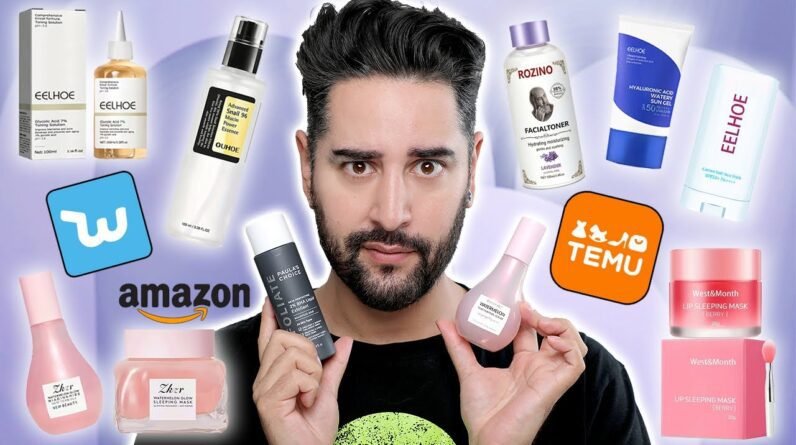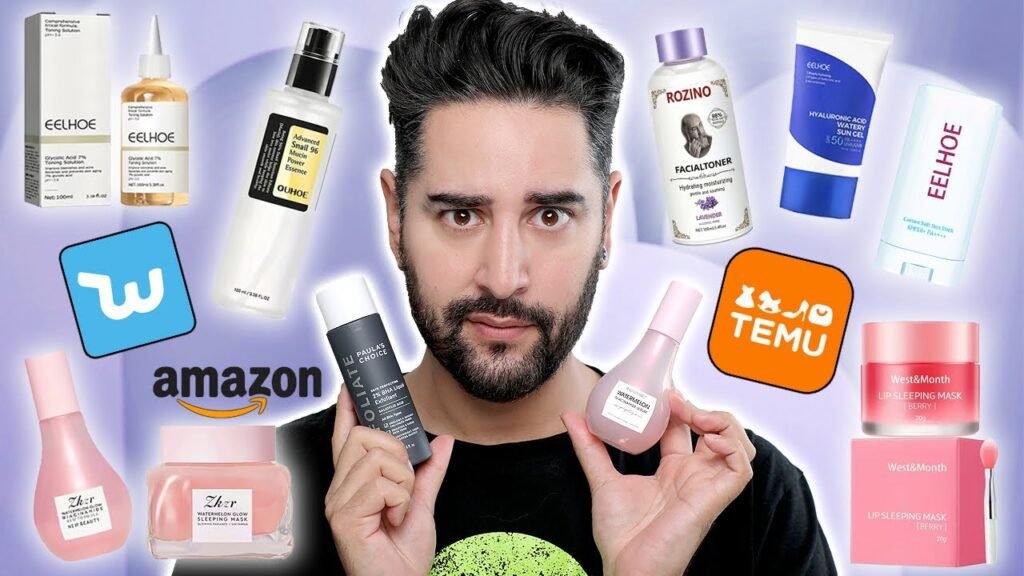
In “Testing FAKE Skincare Products From Temu, Amazon & Wish 💜 James Welsh,” James Welsh explores the world of counterfeit skincare products found on popular online retailers. Concerned about the safety and effectiveness of these products, Welsh tests various fake skincare items from brands like Glow Recipe, COSRX, Paula’s Choice, and more. Throughout the video, he discusses the differences in packaging, texture, smell, and overall quality between the genuine and fake products, emphasizing the importance of purchasing skincare items from reputable sources and warning against buying from unofficial sellers. Welsh’s personal experience of receiving a fake product from an Amazon scam adds to the authenticity of his investigation, leaving viewers questioning the quality and authenticity of these counterfeit products and urging them to be cautious when shopping for skincare online.
In this captivating video on James Welsh’s channel, he takes a terrifying plunge into the world of counterfeit skincare products from popular online retailers like Temu, Amazon, and Wish. With concerns about their safety and effectiveness, Welsh tests various fake skincare items from well-known brands and compares them to the genuine products. He highlights the poor packaging quality, lack of resemblance in texture and smell, and overall questionable quality of the imitations. Throughout the video, Welsh emphasizes the importance of purchasing skincare products from reputable sources and shares his personal story of falling victim to an Amazon scam. This investigation into the world of dupes and counterfeits leaves viewers questioning the authenticity of products they find online and encourages them to be vigilant when shopping for skincare.
Understanding Fake Skincare Products
Fake skincare products are counterfeit or imitation versions of legitimate skincare products, often produced with lower quality ingredients and without proper regulation or oversight. These products are designed to trick consumers into thinking they are purchasing the real product, but they can be ineffective, unsafe, or even harmful to the skin.
Prevalence of Counterfeit Skincare Products in the Market
The market for fake skincare products has become increasingly prevalent, especially with the rise of online shopping platforms. Unauthorized sellers on websites like Amazon, Temu, and Wish have made it easier for counterfeit products to reach consumers. These products are often priced lower than the genuine versions, making them appealing to budget-conscious shoppers.
Understanding Dupe Culture in the Skincare Industry
Dupe culture refers to the practice of creating and selling counterfeit beauty and skincare products that closely resemble popular and expensive brands. Dupe products aim to mimic the packaging, formula, and overall aesthetic of the original product at a lower price point. While some dupe products may simply be affordable alternatives, others can be low-quality imitations that may not deliver the same results as the genuine product.
Identifying Fake Skincare Products
There are several key indicators that can help consumers identify fake skincare products:
Differences in Packaging
One of the most obvious signs of a fake skincare product is discrepancies in packaging. Counterfeit products may have poor printing quality, misspelled words, or incorrect logos. Pay attention to details such as font size, alignment, and overall design. Genuine skincare brands often invest in high-quality packaging that exudes professionalism.
Discrepancies in Smell and Texture
Another way to identify fake skincare products is by examining the smell and texture. Many skincare products have unique scents and consistencies that are difficult to replicate. If the product has an unusual or off-putting smell, or if the texture feels significantly different from what you expect, it may be a fake.
Inconsistency in Product Quality
Counterfeit skincare products are often produced with subpar ingredients and may not deliver the same results as genuine products. Noticeable differences in performance, such as lack of effectiveness or adverse reactions, can indicate that the product is a fake.
Pricing Disparities
If a skincare product’s price seems too good to be true, it likely is. Counterfeit products are often sold at significantly lower prices than genuine ones, luring in unsuspecting customers. Research the average retail price of a product before making a purchase to avoid falling victim to counterfeiters.

Testing Fake Skincare Products from Various Online Retailers
To assess the quality and authenticity of fake skincare products, it is important to conduct thorough testing. This can be done by purchasing products from different online retailers and comparing them to the genuine versions.
Testing Fake Skincare Products from Temu
Temu is one of the online retailers known for selling counterfeit skincare products. By purchasing skincare products from Temu and comparing them to genuine products, it is possible to identify discrepancies in packaging, smell, texture, and overall quality.
Assessing Counterfeit Products from Amazon
Amazon is a popular online marketplace where unauthorized sellers often list counterfeit skincare products. Testing these products from Amazon can help reveal any inconsistencies and safety concerns compared to the genuine versions.
Evaluating Dubious Skincare Products from Wish
Wish is another online platform where counterfeit skincare products are frequently sold. By purchasing and examining skincare products from Wish, it is possible to assess their quality and safety.
Detailed Examination of Fake Skincare Products
Analyzing specific examples of fake skincare products can provide valuable insights into their quality and potential risks. Some notable examples include:
Analysis of Glow Recipe Niacinamide Dew Drops
The fake version of Glow Recipe’s Niacinamide Dew Drops may have poor packaging quality, a different texture, and an off-putting smell. It is essential to compare these attributes to the genuine product to determine its authenticity.
Evaluation of Paula’s Choice Skin Perfecting 2% Liquid Exfoliant
Comparing the texture, smell, and packaging of the fake Paula’s Choice Skin Perfecting 2% Liquid Exfoliant to the genuine product can help identify any inconsistencies. This evaluation can reveal potential safety risks and effectiveness issues.
Inspection of The Ordinary 7% Glycolic Toning Solution
The fake version of The Ordinary’s 7% Glycolic Toning Solution may have different packaging, smell, and texture. Examining these factors can help distinguish the fake product from its genuine counterpart.
Observations on COSRX Advanced Snail Mucin 96 Mucin Power Essence
Fake COSRX Advanced Snail Mucin 96 Mucin Power Essence may have packaging discrepancies and a different consistency compared to the authentic product. These observations can help identify the fake version.
Checks on COSRX Advanced Snail All-In-One Cream
Comparing packaging, smell, and texture between the genuine and fake versions of COSRX Advanced Snail All-In-One Cream can reveal any differences and potential safety concerns.
Study of Thayers Facial Toner
Fake versions of Thayers Facial Toner may have inferior packaging quality, an unusual smell, or inconsistencies in the formula. A thorough examination can help determine the authenticity of the product.
Look into Round Labs Birch Juice Sunscreen
Examining the packaging, texture, scent, and overall performance of the fake Round Labs Birch Juice Sunscreen can reveal any discrepancies and highlight potential risks.
Assessing the Safety of Fake Skincare Products
Counterfeit skincare products pose significant safety concerns for consumers. The use of substandard ingredients, improper manufacturing processes, and lack of regulatory oversight increase the risk of adverse reactions and other health issues.
Concerns about the Safety of Counterfeit Skincare Products
Fake skincare products are often produced without adhering to proper safety standards and regulations. The use of unknown or low-quality ingredients can lead to skin irritation, allergies, infections, and even long-term damage.
Potential Health Risks of Using Fake Skincare Products
Using counterfeit skincare products can have severe consequences for one’s health. Ingredients that are not properly tested or approved can cause adverse reactions, worsen existing skin conditions, and even lead to toxic effects.
Questioning the Ingredients of Fake Skincare Products
Counterfeit skincare products may contain undisclosed or harmful ingredients. Without proper labeling and transparency, consumers are unaware of what they are applying to their skin, increasing the risk of adverse reactions and health complications.
Avoiding Fake Skincare Products
To avoid purchasing fake skincare products, it is crucial to follow certain guidelines and be cautious when shopping:
Importance of Purchasing Skincare Products from Reputable Sources
Always purchase skincare products from reputable sources, such as authorized retailers, official brand websites, or trusted brick-and-mortar stores. These sources are more likely to sell genuine products that have undergone proper testing and quality control.
Tips to Avoid Buying Fake Skincare Products
Research the product and brand before making a purchase to familiarize yourself with the packaging, ingredients, and general performance of the genuine product. Compare prices across different retailers and be skeptical of heavily discounted prices.
Highlighting the Dangers of Buying from Unofficial Retailers
Buying skincare products from unofficial retailers, online marketplaces, or social media ads increases the risk of encountering counterfeit products. Stick to authorized sellers and avoid purchasing from unverified sources.
James Welsh’s Personal Experiences with Fake Skincare Products
James Welsh, a skincare enthusiast and content creator, shares his personal experiences with fake skincare products. He narrates his encounters with counterfeit products and discusses the differences he noticed compared to the genuine versions.
Narration of Receiving a Fake Product from Amazon
James recounts the time he received a fake skincare product from an Amazon scam. He emphasizes the importance of vigilance and research to avoid falling victim to counterfeiters.
Comparing Fake and Real Versions of Various Products
James compares the packaging, smell, texture, and overall quality of fake skincare products to their genuine counterparts. By highlighting the differences, he sheds light on the potential risks associated with using counterfeit products.
Reflections on Experiences with Counterfeit Skincare Products
James reflects on the concerns and frustrations he feels regarding counterfeit skincare products. He emphasizes the need for consumer awareness and stricter regulations to protect both consumers and the skincare industry.
Online Retailers and Responsibility
Online platforms like Amazon have a role to play in tackling the issue of counterfeit skincare products. They must take responsibility for ensuring that only authorized sellers list genuine products on their platforms.
Suspected Unauthorized Sellers on Platforms like Amazon
James expresses his suspicions about unauthorized sellers on platforms like Amazon, who may unknowingly or intentionally sell counterfeit skincare products. He highlights the need for these platforms to implement stricter verification processes for sellers.
Role of Online Platforms in Tackling Counterfeit Skincare Products
Online platforms should prioritize consumer safety by implementing effective measures to identify and remove counterfeit skincare products from their listings. This includes increasing seller verification processes, monitoring product reviews, and addressing consumer complaints promptly.
Need for Stricter Regulations for Online Skincare Product Sales
There is a need for stronger regulations and enforcement practices to prevent the sale of counterfeit skincare products online. Government agencies and industry organizations should work together to establish and implement effective regulations that protect consumers.
Future Plans in Dealing with Fake Skincare Products
James outlines his future plans to address the issue of counterfeit skincare products:
Plans to Do More Research on the Dupe Culture in the Skincare Industry
James intends to conduct further research on the dupe culture in the skincare industry. By understanding the motivations behind counterfeit production and the prevalence of dupe products, he hopes to shed more light on this issue.
Creating Awareness about Counterfeit Skincare Products through Content Creation
James aims to use his platform to raise awareness about the dangers of counterfeit skincare products. He plans to create content that educates consumers on how to identify and avoid fake products, as well as the potential risks associated with using them.
Conclusion
In conclusion, understanding and identifying fake skincare products is essential to protect consumer safety and promote a trustworthy skincare industry. By recognizing the differences in packaging, smell, texture, and product quality, consumers can avoid falling victim to counterfeiters. It is crucial to purchase skincare products from reputable sources, be cautious when shopping online, and support stricter regulations for online skincare sales. Through awareness and education, consumers can make informed choices and prioritize their skin’s health and well-being.






